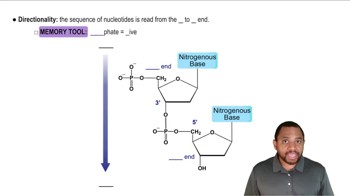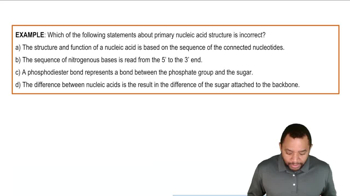Here are the essential concepts you must grasp in order to answer the question correctly.
Polynucleotide Structure
Polynucleotides, such as DNA and RNA, are long chains of nucleotides linked by phosphodiester bonds. Each nucleotide consists of a sugar, a phosphate group, and a nitrogenous base. The sequence and orientation of these nucleotides determine the polynucleotide's function and properties.
Recommended video:
Structural Formula Concept 2
5′ and 3′ Ends
The 5′ end of a polynucleotide refers to the terminal end that has a free phosphate group attached to the fifth carbon of the sugar molecule. Conversely, the 3′ end has a free hydroxyl group attached to the third carbon. This directional difference is crucial for processes like DNA replication and transcription.
Recommended video:
Primary Structure of Nucleic Acids Concept 2
Directionality in Nucleic Acids
Directionality in nucleic acids refers to the orientation of the polynucleotide strand, which is always synthesized in the 5′ to 3′ direction. This means that new nucleotides are added to the 3′ end of the growing strand, influencing how enzymes interact with the DNA or RNA during replication and transcription.
Recommended video:
Primary Structure of Nucleic Acids Example 2
 Verified step by step guidance
Verified step by step guidance


